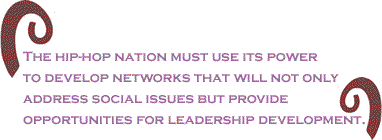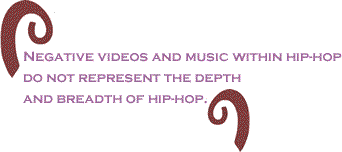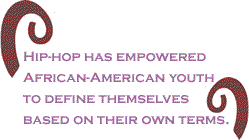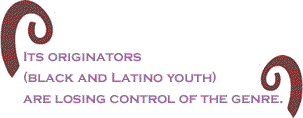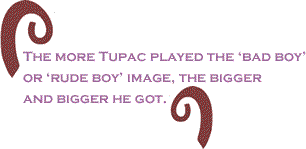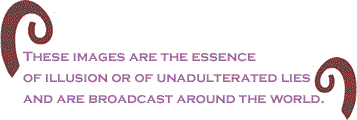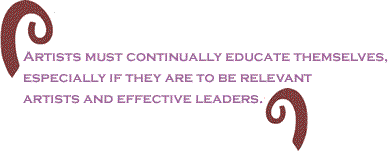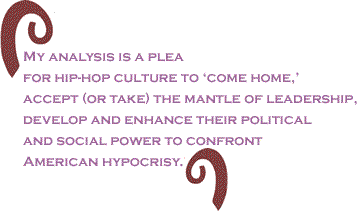
|
|||||||||||||||||||||
 |
Hip-hop has provided a forum for African-American and Latino youth to express their respective cultures and speak on a number of issues. Today, hip-hop is a global phenomenon that appeals to almost all ethnicities and is synthesizing a new culture that goes beyond race, education, and income. Despite the growing acceptance of hip-hop within white America and the middle class, hip-hop is also under siege. Consider the analysis of rap or hip-hop by Bill O’Reilly, popular talk show host of the Fox News Channel:
Clearly, O’Reilly is “from Mars” and does not listen
to hip-hop; he only sees the negative aspects of hip-hop and does not
admit that America has created the conditions for hip-hop and that
the corporations he represents promote the negative
Most importantly, he fails to recognize that white people create ghettos via exclusionary zoning, zoning laws and policies, the real estate industry, the federal government through the Department of Transportation (that built highways through viable urban communities) and Federal Housing Assistance (FHA) loans, which allowed white people to run to the suburbs in the wake of World War II. Music videos, some of the most popular and influential mediums for hip-hop, often depict black and Latino youth as ignorant, lazy, misogynist, and hypersexual. Beyond these negative images, probably the most damning image of hip-hop videos includes those that feature performers with the “bling, bling” – expensive jewelry that suggests prosperity on one hand, and extreme materialism on the other. In reality, these images are part of hip-hop; no artist is forced to write negative lyrics or create harmful videos. However, the negative videos and music within hip-hop do not represent the depth and breadth of hip-hop. Hip-hop speaks to all the major issues of the day – spirituality, leadership, crime, politics, economics – and does so in a way that is entertaining, respectful, and prophetic. Hip-hop has had and will continue to have a profound effect on African-American communities because it is a vehicle for self-expression, a rallying point for activism, and a means for positive youth development. Ultimately, the way hip-hop is presented to global society has political and social implications for black communities because if blacks are portrayed as lazy or ignorant or hypersexual within compact discs (CDs) and videos, African-American youth will unfairly and unjustly be viewed negatively, especially if people from non-black backgrounds have few, if any opportunities to interact with African-Americans and dispel the negative myths and stereotypes. We must dispel some of the myths surrounding hip-hop and show that it goes beyond the “bling, bling” image that is presented to the masses. Furthermore, we must explore the relationship of hip-hop culture, spirituality, political mobilization, leadership (particularly black leadership), and their effects on youth development.
Hip-hop, like many other art forms, is filled with conflicting, often competing messages. Noted social commentator Dr. Michael Eric Dyson highlighted this trend, in 1993:
The excerpt is significant because Dyson crafts an interesting argument; he points out that America created the conditions for the development of hip-hop and gave the genre its context. Moreover, hip-hop provides a forum to address racism and reinforce black culture. Most importantly, hip-hop has empowered African-American youth to define themselves based on their own terms. Finally, hip-hop forces America to look at itself structurally in terms of race, consumption, and violence. Despite the “in-your-face” style of hip-hop in presenting America’s ills, America does not respond to hip-hop as it should. Hip-hop, particularly through the use of videos, at times shows the bleakest of conditions for African-American youth, with dilapidated buildings, dirty streets, unemployment, incarceration, and violence. The images are disturbing; they are the antithesis of America’s image of opportunity for all. Hip-hop videos also challenge the myth that anyone, if they worked hard enough, could experience the “American Dream.” Based on the bleak images and themes presented in hip-hop, one would think that America would rally around the youth portrayed in the videos and address the poverty and social isolation from which many hip-hop artists originate. Unfortunately, America chooses to do very little for the youth and, for the most part, considers the violence and bleakness portrayed in the videos as common, everyday life for black and Latino young people. There are many definitions of hip-hop. Hip-hop pioneer “DJ Africa Bambaataa” describes hip-hop as:
This excerpt is noteworthy because Bambaataa is defining hip-hop as a multiracial, multicultural, borderless movement, with its own attitude, style and rhythm. Speaking to journalist Davey D in 1996, Bambaataa also provided insight on the early days of rap and hip-hop culture:
Bambaataa, at the end of this statement, reveals the biggest challenge to hip-hop: its originators (black and Latino youth) are losing control of the genre. On one hand, the diminishing control and role of African-Americans and Latinos in hip-hop is the natural progression of an international art form; as more cultures become part of hip-hop culture, they will add the uniqueness of their native culture to the art form. Conversely, as hip-hop is distributed by corporate media, its gatekeepers will increasingly define the art form, and only allow certain acts to reach the mainstream. Many of these acts can highlight the worst elements of black, Latino, and American culture: rampant materialism, aggression, misogyny, moral ambiguity, ignorance, and anti-intellectualism. This view is represented by Vanessa Altman-Siegal, when she writes about hip-hop culture in Japan:
Nelson George, in his 1992 book, Buppies, B-Boys, BAPS & Bohos: Notes on Post-Soul Black Culture, highlights how hip-hop has been taken away from its originators and bent to provide a definition of blackness to fuel and enhance other people’s empires:
George’s outlook is also expressed and confirmed by actor, author, slam poet, and hip-hop artist Saul Williams. Williams, in an interview with MotherJones.com’s Jeff Chang, describes and renders a critique of hip-hop when he says:
Williams’ comment suggests that hip-hop has been watered down and co-opted, while leaving its roots as a medium for protest.
Charles “Chuck D” Ridenhour, lead vocalist for, arguably, one of hip-hop’s seminal groups, Public Enemy, also reflects upon the loss of black control in hip-hop, and the exploitation of hip-hop and black culture by white corporate media:
This analysis is very important in that it speaks to the co-optation of hip-hop and Black cultures by white corporations. Moreover, it points to larger, more demeaning trends – the devaluation of black life (black people being portrayed as only valuing entertainment careers instead of academic achievement, science, or service to humanity), anti-intellectualism, and over-consumption. Also, Chuck D adds that the media promotes hip-hop via negative images and messages:
Not only do media promote the negative images of hip-hop, but media also encourages those with positive lyrics to water-down their messages in order to become more commercially appealing. Chuck D substantiates this discourse in his examination of Tupac Shakur:
Corporate control of hip-hop also presents a serious threat to its significance. As corporations promote a sort of hip-hop opium or mind-numbing art that does not address issues, its authenticity and relevance become suspect. Jeff Chang underscored this concept in 2003:
Although Chang offers a number of valuable observations in his article, there is a more sinister motive to corporate control of hip-hop: to destroy African-Americans and, particularly, African-American youth culturally, socially, and intellectually, while reducing them to economic cattle ripe for exploitation. Reflect on the following 1983 analysis by political scientist Manning Marable:
This analysis suggests that corporate control of hip-hop represents the politics and economics of illusion; for every artistic and corporate semi-empire created by P-Diddy, Jay-Z, and OutKast, there are tens of thousands of artists that will NEVER achieve the success of those artists. They will NEVER have the homes or cars of these artists (the homes and settings of many hip-hop artists are not owned by the artists—they are rented), especially those that get people to think about economics, politics, single-parent families, and community on a consistent basis. When these images are juxtaposed with the constant airplay of certain artists on television and radio, there is the appearance that many black and Latino artists have “made it.” These images are the essence of illusion or of unadulterated lies and are broadcast around the world and used to perpetuate already established stereotypes like rampant materialism, violence, and ignorance. The process is examined in a syllabus introduction for a class at Yale University by Steven F. Gray entitled, “Recognizing Stereotypical Images of African Americans in Television and Movies.”
The last paragraph can be easily applied to hip-hop. For the most part, corporate control of hip-hop equates to the worldwide distribution of such clichéd and negative images found in shows like “Amos and Andy.” Furthermore, corporate control of hip-hop becomes an exercise in the replication of exploitation; the models in marketing used by the corporation are now assumed by the artists; the outsourcing of product development (clothes and other items) to foreign countries, paying those employees or independent contractors far below living wages, and selling those products to anxious global markets with astounding product mark-ups. In short, the hip-hop semi-conglomerate learns the following equation: E=MC2, which I translate to Exploitation=Mass Consumption, where the work of underpaid people is used to feed the North American penchant for spending (doubled). There are other ominous aspects of corporate control of the hip-hop. Possibly, the most dangerous aspect of hip-hop is its definitions of maleness, transmitted via the lens of the hip-hop artist versus the entertainer. Within this debate, issues of race and skin color must be explored. Hip-hop sends a number of messages; many male hip-hop artists are dark-skinned and since darkness is associated with such qualities as “sinister” or “menacing” artists may get additional scrutiny from law enforcement. Ife Oshun, hip hop editor for About.com, documented the problem in a March 9 article titled, “Miami Police Practice Rapper Surveillance, Learned From NYPD.”
“Doing something” about the artists and followers of hip-hop means control and surveillance – a clash of cultures based on age, race, and forms of expression. This incident is not limited to Miami; there is an established hip-hop task squad in New York City. Still, there has been policing and profiling of hip-hop artists and followers for years; it is called sales projections, artist recognition, artist personality, and the like by the corporate media. Whatever their backgrounds, those artists that are allowed into the system must be careful not offend white people. At the same time, they are allowed to be “bad,” in that those artists that have been in the prison system or associated with gangs may reflect on their former lives to the public. Again, this shows the reinforcement of negative black stereotypes – all black men (or those that have been in the prison system and those that grew up in urban areas and ghettos) have this badge of “hardness,” affording them more credibility in the “rap game.” (Even the white rapper “Vanilla Ice” associated black cool with street credibility and, in order to appeal to black hip-hop listeners and certify his “badness” to young white females, implied that he grew up in the streets and alluded to gang activity when, in reality, he grew up in the suburbs – a lie perpetuated in his “autobiography.”) Any artist with a dissimilar background, like say, Will Smith (the mega-bucks actor, formerly TV’s “Fresh Prince”), is not viewed as a hip-hop artist – he is an “entertainer.” In a sense, the hip-hop artist has been tamed. He or she may collect the benefits of the industry – hefty promotions budgets, signature clothing lines, and access to the movie business – while bearing no obligation to be prophetic or critical of society.
There is another caveat to hip-hop success; artists must perpetuate the American myth that hard work, pays. In reality, there are too many people in America that work hard and have to settle for crumbs. Yet, youth are encouraged to consume the products of these artists in order to be “hard,” or “down,” or cool. Fitting into American culture has a price. Despite the challenges and problems of the hip-hop culture and industry, hip-hop is evolving. It is moving beyond race, ethnicity, and language to create a new culture. However, this amalgamation of cultures into one culture has its drawbacks. Again, the voices of black and Latino youth may be diluted within the culture. One of the most significant aspects of hip-hop is its teaching function. Its artists not only exist but, they exist to teach their followers. However, artists must continually educate themselves, especially if they are to be relevant artists and effective leaders. What is leadership? James H. Cone examined the question in his 1991 volume, Malcolm & Martin & America: A Dream Or A Nightmare:
On African-American Leadership and Hip-Hop Black leadership has always been hard to define. John White (Black Leadership in America: 1895-1968, New York: Longman, 1985) provides some insights into this dilemma when he quotes James Baldwin:
To quote author Theodore Cross, “Black leadership [and, in my eyes hip-hop] are responses, or, more accurately, challenges to help other blacks reject the mental acceptance and behavioral legitimization of the rules of economic and racial etiquette made by the majority community.” Black artists within hip-hop have to walk a constantly shifting line as they attempt to serve their record label while maintaining their “street credibility.” The artist who loses his street credibility, quickly loses his consumer base – which is, strangely, white suburban males. A great case study in co-optation can be found in an April 2, 2004 article by Ife Oshun:
This brief excerpt shows the duality of the black artist: staying close to his or her base while expanding to reach larger (younger, white) audiences. Time will tell if 50 Cent will be viewed as an artist that “sold out.” According to The New York Press, the selling out process has already begun. Back in 1967, Stokely Carmichael and Charles V. Hamilton (Black Power: The Politics of Liberation in America) provided an analysis that could be crucial to today’s African-American hip-hop artists:
Today, Hamilton and (now-deceased) Carmichael might argue that true hip-hop (political, prophetic, spiritual, and instructive) is an exercise in risk. In short, Paris, Public Enemy, Common, KRS-1 (notice that I have failed to mention any women) and others will never sell as many CDs as Petey Pablo, Nelly, P-Diddy, or Eminem.
This analysis brings us to one of the most interesting issues in hip-hop: satisfying white suburban males and middle-class African-Americans. To highlight this concern, I wrote a poem, “The Devolution IS Being Televised.” In this poem I describe how African-American culture and self-definition is being destroyed and co-opted. Consider this verse:
I hypothesize that white males, in particular, listen to rap, the major medium of hip-hop, to add another dimension to their warped concepts of manhood and African-American manhood. In brief, they want “black cool” without living next to black people. Therefore, they are not exposed to the true spectrum of black manhood and black self-definition. Subsequently, for the few suburban black counterparts that white males have, they take on the illusion of being “hard” and “representin’” when, in reality, they mimic the mores and actions of their white counterparts. In short, they want to live “ghetto” and be “hard core” while strictly living suburban middle class, without any connection to the black urban masses. In a 1992 commentary, Manning Marable examined the chasm between the black middle class and the black masses:
Social and political philosopher Bernard Boxill (Blacks And Social Justice, 1992) also indicts the black middle class by noting that it "uses the misery of the black underclass [more] to…its benefit than to the benefit of the black underclass." This situation is significant in that it challenges the notion of a collective, singular "black community." It also questions the commitment of black leaders from the middle class to effectively meet the needs of the black masses. This argument can be taken further and applied to the hip-hop artist and his or her roots. Malcolm X, in many of his speeches and public statements, also pointed out the class divisions ("house Negroes" and "field Negroes") blacks inherited from slavery, which could be applied to the assimilation of black and brown artists of the hip-hop culture and industry into white corporate culture:
Although I could name artists that could be viewed as field negroes, I will leave it to the readers to determine the artists that are the house and field African-Americans.
Cornel West (Race Matters, 1993) provides some of the most damning analysis of the black middle class:
In retrospect, my analysis is a plea for black and Latino segments or the majority of the hip-hop culture to “come home,” accept (or take) the mantle of leadership, develop and enhance their political and social power to confront American hypocrisy. As an elder member of the hip-hop community, I argue that our time is NOW. Let us highlight the angry, analytical, and prophetic forms of hip-hop, not hip-pop. We must reinvent Black Power. Black power, according to LeRoi Jones (now Amiri Baraka), is more than a means to an end; it is a movement, a process involving a cultural awareness and requiring a spiritual focus:
The hip-hop nation must use its power to develop networks and other innovative projects that will not only address social issues but provide opportunities for leadership development. It must not let young people "fall through the cracks" of society like the elder generation allowed to happen. This is why the recent hip-hop political convention is/was important – it is the beginning of the revolution! Long live hip-hop! Reverend Reynard N. Blake, Jr., M. S. is a recently ordained Baptist minister and president of Community Development Associates, an East Lansing, Michigan-based business dedicated to helping faith-based and nonprofit organizations. He earned his Master of Science degrees in Community Development and Urban Studies from Michigan State University and a Bachelor of Arts degree in English from the College of Charleston (SC). He has co-authored an article with June Manning Thomas on the role of African-American faith-based organizations in community economic development, which was featured in the book, Revitalizing Urban Neighborhoods (1996). He has also written articles for the Journal of Urban Youth Culture, Michigan Family Review, and the Charleston (SC) Chronicle. Presently, he is conducting research for a book on hip-hop and youth development to be completed (hopefully) in 2005. He is a graduate student in the Pastoral Ministry program at Marygrove College in Detroit, Michigan. Blake is a Bronx, New York native and witnessed the birth of hip-hop and has been fascinated by the social, political, spiritual, and cultural dimensions of hip-hop as an art form. |
July
15 2004 |
|||||||||
|
|||||||||
|
|
|||||||||
| Printer Friendly Version | |||||||||
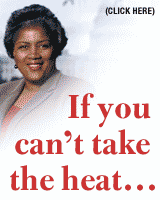 |
|||||||||
| |
|||||||||
| |
|||||||||





















